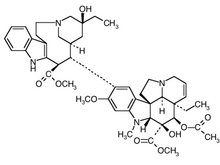Definition
Vinblastine is a drug used to treat certain types of cancer. Vinblastine is available under the trade names Velban and Velsar, and may also be referred to as vinblastine sulfate. The drug was previously known as vincaleukoblastine or VLB.
Purpose
Vinblastine is an antineoplastic agent used to treat Hodgkin's disease, non-Hodgkin's lymphomas, mycosis fungoides, cancer of the testis, Kaposi's sarcoma, Letterer-Siwe disease, as well as other cancers.
Description
Vinblastine was approved by the Food and Drug Administration (FDA) in 1961.
Vinblastine is a naturally occurring compound that is extracted from periwinkle plants. It belongs to a group of chemicals called alkaloids. The chemical structure and biological action of vinblastine is similar to vincristine and vinorelbine.
Vinblastine prevents the formation of microtubules in cells. One of the roles of microtubules is to aid in the replication of cells. By disrupting this function, vinblastine inhibits cell replication, including the replication the cancer cells.
Vinblastine is one the most effective treatments for Hodgkin's disease, and is typically used in combination with doxorubicin, bleomycin and dacarbazine. It is also used to treat non-Hodgkin's lymphomas, mycosis fungoides, and Letterer-Siwe disease. Vinblastine is also used to treat cancer of the testis in combination with other cancer drugs, and Kaposi's sarcoma alone, or in combination with other drugs. Vinblastine is also used less frequently to treat other types of cancer.
Recommended dosage
Vinblastine is administered by intravenous injection at intervals of at least seven days. Blood tests may be necessary every seven days to ensure that enough white blood cells are present to continue treatment. The initial dose of vinblastine may be adjusted upward or downward depending on patient tolerance to the toxic side effects of treatment. The minimum recommended treatment duration is four to six weeks.
Precautions
Vinblastine must only be administered by individuals experienced in the use of this cancer chemotherapeutic agent. Vinblastine must only be administered intravenously, that is, directly into a vein. Accidental administration of vinblastine into the spinal cord fluid is a medical emergency that may result in death. Vinblastine has a low therapeutic index. It is unlikely there will be therapeutic benefit without toxic side effects. Certain complications can only be managed by a physician experienced in the use of cancer chemotherapeutic agents.
Because vinblastine is administered intravenously, the site of infusion and surrounding tissue should be monitored for signs of inflammation and irritation.
Adverse side effects are more likely in patients with malnutrition or skin ulceration.
Blood tests may be necessary to ensure that the number of white blood cells is adequate for treatment to continue. Vinblastine is not recommended for use in patients with low white blood cell levels. Infections should also be controlled before vinblastine treatment.
Patients should inform their physician if they experience sore throat, fever, chills, or sore mouth and any serious medical event.
Vinblastine may cause harm to a fetus when administered to pregnant women. Only in life-threatening situations, should this treatment be used during pregnancy. Women of childbearing age are advised not to become pregnant during treatment. Women should stop nursing before beginning treatment, due to the potential for serious adverse side effects in the nursing infants.
Side effects
The side effects of vinblastine treatment are usually related to the dose of drug and are generally reversible. Toxic side effects are more common in patients with poor liver function.
A decrease in the number of white blood cells is the principal adverse side effect associated with vinblastine treatment. Blood tests will allow a doctor to determine if there are an adequate number of white blood cells to begin or continue treatment. Nausea and vomiting may occur, for which antiemetic agents are usually effective. Shortness of breath is a potentially severe side effect that patients should report to their doctor.
Additional side effects, including loss of appetite (anorexia), diarrhea, constipation, pain, rectal bleeding, dizziness, hearing impairment, and hair loss (alopecia) may occur.
Interactions
Drugs that may alter the metabolism of vinblastine, particularly itraconazole, should be used with caution due to the potential for interactions. Hearing impairment may be enhanced when vinblastine is used with other drugs that affect the ear. These drugs include platinum-containing antineoplastic agents, such as cisplatin. Seizures have been reported in patients taking vinblastine and phenytoin. The doses of vinblastine and phenytoin may need to be adjusted to decrease the chance of this problem.
KEY TERMS
- Alkaloid
- A nitrogen-containing compound occurring in plants.
- Microtubles
- A tubular structure located in cells that help them to replicate.
- Therapeutic index
- A ratio of the maximum tolerated dose of a drug divided by the dose used in treatment.



